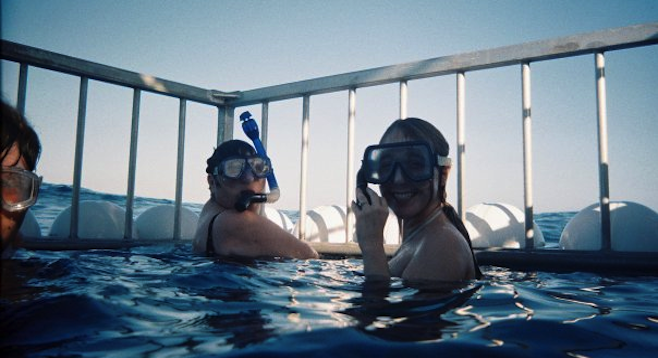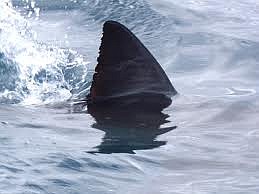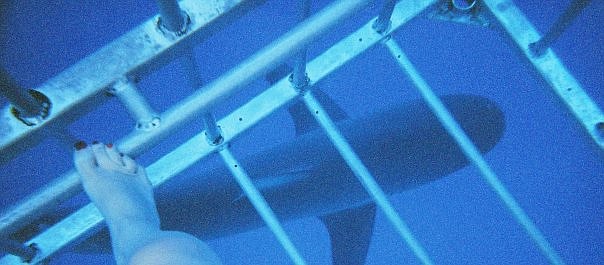 Facebook
Facebook
 X
X
 Instagram
Instagram
 TikTok
TikTok
 Youtube
Youtube

If you're in Oahu and seen enough scary people in panda suits waiting for you to give them money so they can lunge at your face, why not try a shark cage tour?
There is a debate in Hawaii about that very question. Locals argue about whether the tours are good for the sharks, whether they're good for the people sticking their hands out of the cages to pet the sharks, and what kind of liability such stupidity will rain down on the small companies that run the tours.
The debate continues in Oahu, and, to my knowledge, such tours no longer exist on other Hawaiian islands. The other sharks go about their badass, black-eyed lives unbothered. The tourists keep their fingers (thus, throwing yet another wrench in Darwin's plan), and small businesses move onto less risky things, like shark freediving.
While on a family vacation in Hawaii, my father especially was anxious that we participate in a shark cage tour. He'd done it before. He'd been stung across his chest by jellyfish and puked on by seasick jocks, so naturally he felt a strong urge to return.
My mother and brother were both committal and non-committal at the same time. I don't know how they managed it but they did. I suspect it's a mix of "I don't really care if we do this although I'd rather not" with a small dose of "Your father won't shut up about this for years if I don't get on the damn boat." On the boat they came, their gazes steadfast and mildly bored with the occasional flash of terror as we pushed farther out to sea.
We had with us a party of about 15. The two crewmen, my family of four and two other families that looked remarkably similar. They were all large, white, and had conversations filled with phrases like, "DONNIE, GET YOUR FINGERS OFF THAT STEERING WHEEL!" They were loud but they were friendly. And I knew I could out-swim them.
If you've been on any water tour, then you already know the crew. Baseball caps or short cropped hair, t-shirts with the company name, sun-craggled faces, indifferent and slightly annoyed. But you know (or, you hope you know) they'd risk their lives for you (up to a certain point – I mean, honestly, there's got to be a point where you'd just say, "You’re an idiot, you're on your own," but to their credit I've never seen them get there).
As we moved out to sea, they started the "talks" about boat and cage safety, as well as the environmental debate with a slight bias. They told us to try not to pet the sharks or accidentally leave an appendage hanging out of the cage. I started to laugh when they said "please don't try to pet the sharks," but then I looked at my group. And I understood. They were disappointed. I began to wonder if the woman in the tankini standing recklessly on the back of the boat and her family had really thought this thing through.
The crew then went onto tell us that they ran this operation because they loved the ocean. They loved the sharks. They felt the experience brought people a better understanding of sharks, and they did not want to be shut down.
On and on went the boat into open water until we couldn't see the shoreline. The crew then announced without prelude that sharks were usually seen in this area. Almost on cue, big, sleek, dark shapes appeared when the boat's engines were cut, and a metal cage of about 8'x5' was dropped into the water and assembled. A ladder was attached to the boat's edge. It started above deck and ended in the cage somewhere underwater.
Ok, we were told, anytime you want, go on in.
There is a moment with things like this, when everyone looks at everyone else. There's silence and wide eyes and unspoken questions. Is this the most stupid thing we could have done this morning? Did I ever change that will? Who's going in first?
After a healthy moment of silence, a middle-aged man popped his snorkeling gear on, and with a, "There's nothing to be afraid of, you guys are weak!" lowered himself into the water slower than a sloth on muscle relaxants. His teenage son followed him in faster, having learned to fake manliness early in his young life. They both lasted about five minutes, shouting things like "Oh MY GOD that's close!" and "Are they usually this big? I mean, I know they're BIG, but are they supposed to be THIS BIG?", before falling back onto the boat because they'd forgotten to take off their flippers. They never went back. But you know what? Everything else aside, it took guts to be the first ones in.
Having seen the sharks surrounding the cage and it maintaining its integrity with the two bigger, flailing men inside, I volunteered to go with the next group. As soon as I hit the water, there were the fins.

Big fins, small fins, medium fins. They sliced in and out of the air in constant motion, sometimes graceful, sometimes sloppy with wet kickback and waves. The sharks were between three and seven feet, the crew guessed, of a variety of those commonly found in those waters. I froze for a minute as the adrenaline started to run and the theme from Jaws began playing in my head.
One deep breath, two deep breaths... jump. There was a rush of water and panic, and then I took a clear snorkel breath. I opened my eyes to see that my mask was clear and leak-free, and ever so slowly a sense of calm overcame me. Then the excitement started to build as the shapes came together underwater.
I swam to the farthest edge of the cage, a comfortable place to stay for awhile. There are fewer people around unaccustomed to open water movement and likely to knock you into the bars while trying to get their bearings.
With my head submerged I looked around. There were plenty of them, but they were keeping away because the cage was a new addition to their environment. I imagine it was sort of like if someone drove up to your house and threw a hamster ball through the living room window – you're curious but cautious because people don’t generally do that sort of thing.
I felt safe holding onto the bars and balancing my flippers on the cage bottom (do NOT do this). Only the very tips of my fingers were outside the cage but I was able to hang on and be steady in the rocking water – having small hands is useful sometimes.

I could see the sleek gray scales, the shine of their skin. Their eyes were black but alive – no one could confuse them with the steadfast stare of a stuffed animal. There was something akin to curiosity, occasionally holding my glance before sliding back into the darkness around us. They got used to us and started to come closer, one actually bumping the cage (I believe by accident, the cage was moving with the water, but I could be wrong). I loved every second. The crew was right on that count – I felt a connection, a curiosity to learn more that comes only from direct contact with wild animals.
Time was up too soon and I lingered in the water until the crew got cranky. I finally climbed out, they collapsed the cage, pulled the ladder and off we raced to shore. The ride back was a nice one, fast and sort of bumpy, and I sat under the hull with my family to stay dry and warm. Tankini was still propped on the edge of the back of the boat.
Images of Goldie Hawn reaching for her ring in Overboard came to mind, but by some miracle (and, yes, weight) she stayed on. No one fell overboard that day, and only half decided to go in the water. But everyone had fun with a little mix of fear, which made them happy. And then they all bought sweatshirts, which made the crew happy.
The tours are still running. Admittedly, I'd do it again in a heartbeat. And I'd pay for it.
*Travel tip: Take a digital camera if you're shooting underwater. Make sure you have a dry and stable place to see what you've taken. Be sure to wipe down the lens (spit helps defog a camera lens, in addition to defogging your goggles - spit or fuzzy photos, you choose). Just don't give up too much time taking underwater photos because good ones are near impossible without great (read "insanely expensive") underwater gear. The best bet is to take a million up front and then put the camera away. Or, just take the experience and have someone else be the photographer.


If you're in Oahu and seen enough scary people in panda suits waiting for you to give them money so they can lunge at your face, why not try a shark cage tour?
There is a debate in Hawaii about that very question. Locals argue about whether the tours are good for the sharks, whether they're good for the people sticking their hands out of the cages to pet the sharks, and what kind of liability such stupidity will rain down on the small companies that run the tours.
The debate continues in Oahu, and, to my knowledge, such tours no longer exist on other Hawaiian islands. The other sharks go about their badass, black-eyed lives unbothered. The tourists keep their fingers (thus, throwing yet another wrench in Darwin's plan), and small businesses move onto less risky things, like shark freediving.
While on a family vacation in Hawaii, my father especially was anxious that we participate in a shark cage tour. He'd done it before. He'd been stung across his chest by jellyfish and puked on by seasick jocks, so naturally he felt a strong urge to return.
My mother and brother were both committal and non-committal at the same time. I don't know how they managed it but they did. I suspect it's a mix of "I don't really care if we do this although I'd rather not" with a small dose of "Your father won't shut up about this for years if I don't get on the damn boat." On the boat they came, their gazes steadfast and mildly bored with the occasional flash of terror as we pushed farther out to sea.
We had with us a party of about 15. The two crewmen, my family of four and two other families that looked remarkably similar. They were all large, white, and had conversations filled with phrases like, "DONNIE, GET YOUR FINGERS OFF THAT STEERING WHEEL!" They were loud but they were friendly. And I knew I could out-swim them.
If you've been on any water tour, then you already know the crew. Baseball caps or short cropped hair, t-shirts with the company name, sun-craggled faces, indifferent and slightly annoyed. But you know (or, you hope you know) they'd risk their lives for you (up to a certain point – I mean, honestly, there's got to be a point where you'd just say, "You’re an idiot, you're on your own," but to their credit I've never seen them get there).
As we moved out to sea, they started the "talks" about boat and cage safety, as well as the environmental debate with a slight bias. They told us to try not to pet the sharks or accidentally leave an appendage hanging out of the cage. I started to laugh when they said "please don't try to pet the sharks," but then I looked at my group. And I understood. They were disappointed. I began to wonder if the woman in the tankini standing recklessly on the back of the boat and her family had really thought this thing through.
The crew then went onto tell us that they ran this operation because they loved the ocean. They loved the sharks. They felt the experience brought people a better understanding of sharks, and they did not want to be shut down.
On and on went the boat into open water until we couldn't see the shoreline. The crew then announced without prelude that sharks were usually seen in this area. Almost on cue, big, sleek, dark shapes appeared when the boat's engines were cut, and a metal cage of about 8'x5' was dropped into the water and assembled. A ladder was attached to the boat's edge. It started above deck and ended in the cage somewhere underwater.
Ok, we were told, anytime you want, go on in.
There is a moment with things like this, when everyone looks at everyone else. There's silence and wide eyes and unspoken questions. Is this the most stupid thing we could have done this morning? Did I ever change that will? Who's going in first?
After a healthy moment of silence, a middle-aged man popped his snorkeling gear on, and with a, "There's nothing to be afraid of, you guys are weak!" lowered himself into the water slower than a sloth on muscle relaxants. His teenage son followed him in faster, having learned to fake manliness early in his young life. They both lasted about five minutes, shouting things like "Oh MY GOD that's close!" and "Are they usually this big? I mean, I know they're BIG, but are they supposed to be THIS BIG?", before falling back onto the boat because they'd forgotten to take off their flippers. They never went back. But you know what? Everything else aside, it took guts to be the first ones in.
Having seen the sharks surrounding the cage and it maintaining its integrity with the two bigger, flailing men inside, I volunteered to go with the next group. As soon as I hit the water, there were the fins.

Big fins, small fins, medium fins. They sliced in and out of the air in constant motion, sometimes graceful, sometimes sloppy with wet kickback and waves. The sharks were between three and seven feet, the crew guessed, of a variety of those commonly found in those waters. I froze for a minute as the adrenaline started to run and the theme from Jaws began playing in my head.
One deep breath, two deep breaths... jump. There was a rush of water and panic, and then I took a clear snorkel breath. I opened my eyes to see that my mask was clear and leak-free, and ever so slowly a sense of calm overcame me. Then the excitement started to build as the shapes came together underwater.
I swam to the farthest edge of the cage, a comfortable place to stay for awhile. There are fewer people around unaccustomed to open water movement and likely to knock you into the bars while trying to get their bearings.
With my head submerged I looked around. There were plenty of them, but they were keeping away because the cage was a new addition to their environment. I imagine it was sort of like if someone drove up to your house and threw a hamster ball through the living room window – you're curious but cautious because people don’t generally do that sort of thing.
I felt safe holding onto the bars and balancing my flippers on the cage bottom (do NOT do this). Only the very tips of my fingers were outside the cage but I was able to hang on and be steady in the rocking water – having small hands is useful sometimes.

I could see the sleek gray scales, the shine of their skin. Their eyes were black but alive – no one could confuse them with the steadfast stare of a stuffed animal. There was something akin to curiosity, occasionally holding my glance before sliding back into the darkness around us. They got used to us and started to come closer, one actually bumping the cage (I believe by accident, the cage was moving with the water, but I could be wrong). I loved every second. The crew was right on that count – I felt a connection, a curiosity to learn more that comes only from direct contact with wild animals.
Time was up too soon and I lingered in the water until the crew got cranky. I finally climbed out, they collapsed the cage, pulled the ladder and off we raced to shore. The ride back was a nice one, fast and sort of bumpy, and I sat under the hull with my family to stay dry and warm. Tankini was still propped on the edge of the back of the boat.
Images of Goldie Hawn reaching for her ring in Overboard came to mind, but by some miracle (and, yes, weight) she stayed on. No one fell overboard that day, and only half decided to go in the water. But everyone had fun with a little mix of fear, which made them happy. And then they all bought sweatshirts, which made the crew happy.
The tours are still running. Admittedly, I'd do it again in a heartbeat. And I'd pay for it.
*Travel tip: Take a digital camera if you're shooting underwater. Make sure you have a dry and stable place to see what you've taken. Be sure to wipe down the lens (spit helps defog a camera lens, in addition to defogging your goggles - spit or fuzzy photos, you choose). Just don't give up too much time taking underwater photos because good ones are near impossible without great (read "insanely expensive") underwater gear. The best bet is to take a million up front and then put the camera away. Or, just take the experience and have someone else be the photographer.
Comments